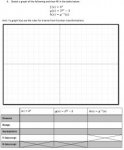Hey,
I'm working on an inverse graph for pre-calc 12 and it says i have to graph
h(x)=(g^-1)(X).
My teacher hinted that we have to find the inverse for this, but the only thing I could come up with was the following:
h(x)=(1/g)(x)
Unfortunately I have no clue how to graph this because there is more then one variable and my graphing calc won't accept the "g" value.
Could someone suggest what I have to do to graph this?
I'm working on an inverse graph for pre-calc 12 and it says i have to graph
h(x)=(g^-1)(X).
My teacher hinted that we have to find the inverse for this, but the only thing I could come up with was the following:
h(x)=(1/g)(x)
Unfortunately I have no clue how to graph this because there is more then one variable and my graphing calc won't accept the "g" value.
Could someone suggest what I have to do to graph this?


